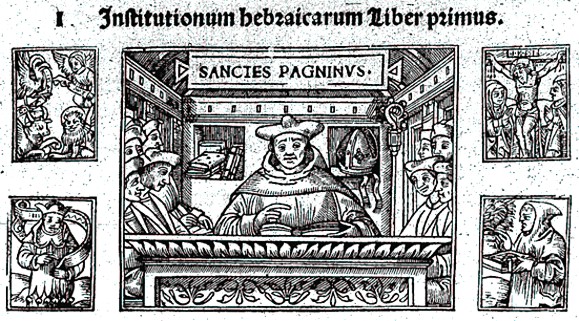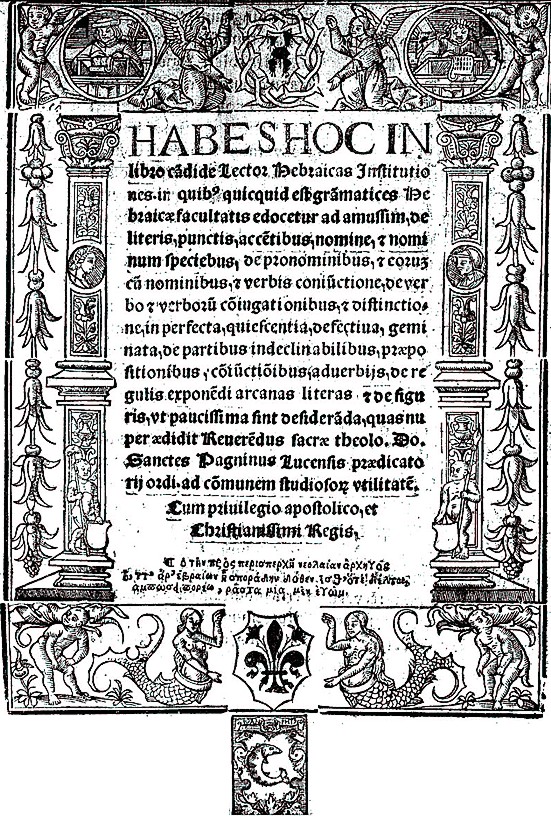|
Manuscripts
have been written by scribes with the inspired Greek Scriptures on the
one side of the page and the Latin Vulgate translation alongside on
the opposite side of the same page. This allowed for a comparing of
the two language texts. Had the Latin translation of the whole Bible
as made by the Catholic translator Jerome been made with the "correct
words of truth"? Well, let those who know Latin and Greek compare
the two texts and see for themselves. been made with the "correct
words of truth"? Well, let those who know Latin and Greek compare
the two texts and see for themselves.
In
the year 1528 an Italian monk named Sanctes Pagninus published in
Lyons, France, a work on which he had labored for thirty years. Its
Latin title, translated into English, is "A New Translation of
the Old and the New Testament." The translation was, of course,
into Latin. Later an edition of this was published in Lyons, in 1542,
by Servetus. However, in the meantime, along came the Spanish priest
and Orientalist named Arias Montanus. King Philip II of Spain called
him to labor at a projected Polyglot Bible, which the king was causing
to be made at the suggestion of the famous printer, Plantin. Finally,
in 1569-1572, this Bible was printed in Antwerp. Its Latin title,
translated into English, is "The Sacred Bible in Hebrew, Chaldaic,
Greek and Latin, of Philip II, King, Catholic in Piety and Study,
toward the Sacrosanct Church’s Use," printed by Plantin, in
eight (8) volumes, folio size. Because of the place where printed it
is generally called the "Antwerp Polyglot." Sometimes it is
called the "Royal Bible," because of the patronage of King
Philip II; and sometimes, the "Plantinian Bible", after the
printer. Sometimes it is
called the "Royal Bible," because of the patronage of King
Philip II; and sometimes, the "Plantinian Bible", after the
printer.
In
this Antwerp Polyglot the Spanish priest Arias Montanus incorporated a
correction of the Latin translation of the Bible by Sanctes Pagninus.
Years later, Arias Montanus died, in 1598. In the year 1599 and the
years 1610-1613 editions of the Latin text of the Bible by Pagninus
appeared, which editions gave an interlinear and word-for-word
translation of the Hebrew with the Hebrew vowel points and with the
Latin translation appearing above the Hebrew text. This Hebrew-Latin
Bible was long considered the most convenient Hebrew Bible for those
beginning to learn Hebrew. The Watch Tower Bible & Tract Society
of Pennsylvania possesses original copies of the interlinear
translation printed by the Plantinian printshop, and the eleven
volumes bear the dates of 1610, 1611, 1612, 1613 and 1615. Volume I,
containing the Bible books Genesis and Exodus bears the Latin title,
which, translated into English, is "Hebrew Bible with Interlinear
Latin Interpretation of Sanctes Pagninus of Lucca."
The
tenth volume, which begins with the Gospel of Matthew, bears the title
that, translated into English, reads: "Greek New Testament with
the Common Latin Interpretation Inserted in the Lines of the Greek
Context, which interpretation, indeed,... expressing the sense,
evidently, rather than the words, is placed alongside in the margin of
the book, and another of the Blessed Arias Montanus the Spaniard,..."
In this volume the Latin translation appears above the Greek text,
word for word.
Thus
at the close of the sixteenth century and beginning of the seventeenth
century we have this interlinear and word-for-word translation of the
Bible appearing. The foregoing interlinear material was incorporated
in the Polyglot Bible, which was published in 1654-1657 by the noted
British prelate, Dr. Brian Walton. Original copies of this massive
work, in eight large volumes, are possessed by the Watch Tower Bible
and Tract Society of Pennsylvania. The heading above the interlinear
section for the Hebrew text and the heading above that for the Greek
text mention the Italian monk Pagninus and the Spanish priest Arias
Montanus to show the origin of the material.
Two
hundred years later comes forth something more practical for Bible
students in general. In the year 1857 Benjamin Wilson, a newspaper
editor in Geneva, Illinois, U.S.A., published the first section of his
interlinear translation of the inspired Greek Scriptures. The final
section was issued in 1863. It was issued as one bound volume in 1864
and was called "The Emphatic Diaglott". The name "Diaglott"
means, literally, "through tongue," but is understood to
signify "interlinear." In 1902 the copyright and plates of
the Diaglott were bought from the Fowler & Wells Company of New
York city and were presented as a gift to the Watch Tower Bible &
Tract Society, Charles Taze Russell being then president of the
Society.
In
the broad left-hand column of each page the Diaglott presents the
Greek text, using the recension made by the German Dr. J. J. Griesbach
in 1775-1777, and under each Greek word is presented its English
equivalent. In the slim right-hand column of each page is presented a
modern English translation as made by Benjamin Wilson.
It was through The Emphatic Diaglott that the Society’s first
president, C. T. Russell, learned that the inspired Greek Scriptures
speak of the second "presence" of Christ, for the Diaglott
translated the Greek word "parousia" correctly as "presence",
and not as "coming" like the King James Version Bible.
Accordingly when C. T. Russell began publishing the new Bible magazine
in July of 1879, he called it Zion’s Watch Tower and Herald of
Christ Presence. Today, this magazine is entitled "The Watchtower
Announcing Jehovah’s Kingdom", and is published in 125
languages. Apparently, in first naming the magazine in 1879 Editor
Russell was unaware that in 1862, or a year before The Emphatic
Diaglott was completed, Dr. Robert Young had published in Edinburgh,
Scotland, the Bible translation called "Young’s Literal
Translation of the Holy Bible" and that this translation also
translated the Greek word "parousia" as "presence"
and not as "coming". He also produced the Young's Analytical
Concordance to the Bible, which, on page 188, column 1, shows parousia
to mean "a being alongside", or "presence". The
Watch Tower issue of April, 1883, recommended this Concordance to
Bible students.
After
The Emphatic Diaglott there came other interlinear translations
of the Sacred Scriptures. In the year 1877 there was published in
London, England, by Samuel Bagster and Sons, Limited, what was called
"The Englishman’s Greek New Testament", giving an
interlinear word-for-word translation under the Greek text of
Stephanus of 1550, along with the King James Authorized Version
of 1611 in the outer column of each page. Later, in 1960, this same
publishing company brought out The Interlinear Greek-English New
Testament. This presented in the right-hand column of each page
the Greek text as compiled by the German scholar Eberhard Nestle as of
1898 with a word-for-word translation underneath as made by Dr. Alfred
Marshall. Alongside, in the left-hand column of each page, was printed
the King James or Authorized Version translation. As for
an interlinear translation of the Hebrew Scriptures, there was
published in Chicago, Illinois, U.S.A., in 1896, The Interlinear
Literal Translation of the Hebrew Old Testament. Only volume one
has appeared, containing Genesis and Exodus, the interlinear
translation being done by George Ricker Berry, Ph.D.
|


![]() - Lione, 1526
- Lione, 1526